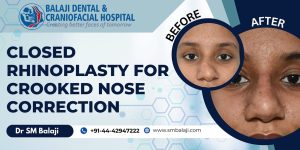Patient with facial asymmetry from a very young age in life
The patient is a 23-year-old female from Hubli in Karnataka, India. She had developed right-sided facial asymmetry from a very young age in life. Her parents had taken her to a local hospital where genetic testing had been performed. It had returned with the diagnosis of hemifacial microsomia.
Her facial asymmetry had gotten progressively worse with the passage of time. The right side of her mandible was extremely hypoplastic. She had problems with speech and eating due to this. Upper lip and lower lip function have always been normal. External ear deformity can also occur with hemifacial microsomia.
The patient had also faced significant bullying in school and college. She has always been introverted and considered books to be her best friends.
What is hemifacial microsomia and how is it corrected?
Hemifacial microsomia is a congenital disorder that affects the development of the lower half of the face. It most commonly affects the ears, mouth and mandible. There is marked facial asymmetry with resultant disfigurement of the face.
Hemifacial microsomia is the second most common birth defect of the face after cleft lip and palate deformity. Craniofacial microsomia involves structures of the upper cranium along with the usual facial involvement. Deformities related to children with cleft lip never overlaps hemifacial microsomia.
Parents decide to obtain surgical correction of her facial asymmetry
Around a year ago, her parents began making extensive enquiries regarding the best treatment center to address her problems. They were finally referred to our hospital for surgical management of her problem.
Hemifacial microsomia surgery is performed by only a few hospitals in India. Hemifacial microsomia correction requires years of highly specialized surgical training and experience.
Initial presentation at our hospital for management of her problem
Dr SM Balaji, hemifacial microsomia surgeon, examined the patient and obtained pertinent imaging studies including a 3D CT scan. It revealed that the patient had an extremely hypoplastic mandible including condyle, coronoid process and ramus. Meticulous treatment planning was made for the patient.
Treatment planning explained to the patient and parents in detail
It was explained to the patient and her parents that she needed to undergo a two-stage surgical correction of her facial asymmetry. The first stage would include mandibular condylar reconstruction along with coronoid and ramus reconstruction. This would be performed through utilization of bone grafts harvested from the patient.
This would be followed by a period of six months for full bony consolidation of the grafts. Mandibular distraction osteogenesis would then be performed along with maxillary Le Fort I surgery for facial asymmetry correction. This would be through lengthening of the ramus. The patient was in agreement with the treatment plan and consented to surgery.
The patient underwent the first stage of surgical treatment. She was discharged home with instructions on postsurgical care and to return in six months for the second stage of surgery.
Patient presents for placement of internal distractor and Le Fort I surgery
The patient returned to the hospital for placement of mandibular ramus distractors and Le Fort I osteotomy. Radiographic imaging of her right mandible including a 3D CT scan was obtained. This demonstrated a well-formed right condyle, coronoid and ramus.
Successful surgical correction of her facial asymmetry
Under general anesthesia, an incision was placed in the right submandibular region. Dissection was performed down to the right mandibular ramus. The plates from the previous surgery were removed. This was followed by a horizontal bone cut to the ramus.
The mandibular ramus distractor was then fixed using titanium screws. Distraction function was checked and was optimal.
Attention was next turned to the maxilla. A sulcular incision was placed in the vestibular region and Le Fort I osteotomy was performed.
This was followed by mobilization of the maxilla. The posterior end of the left maxilla was fixed using transosseous wires. This would ensure that the occlusal cant was corrected. Hemostasis was achieved and closure was done.
Postsurgical phase of the hemifacial microsomia correction
A latency period of six to seven days was given following surgery. The distractor was then activated by 1 mm each day for a total distraction of around 14 mm. This resulted in achieving a satisfactory increase in the length of the ramus. A plate was fixed to the right posterior maxilla to prevent further downward movement.
The final phase of the surgery in three to four months for distractor removal
The patient was very happy with the cosmetic results of the surgery after completion of the distraction phase of the treatment. She and her parents were instructed to return in three to four months for removal of the distractor. This would result in the complete rehabilitation of the patient after surgery.





